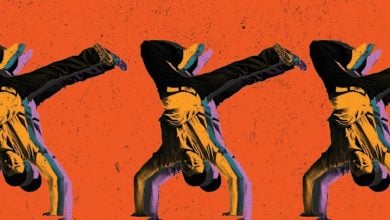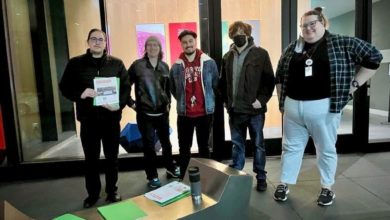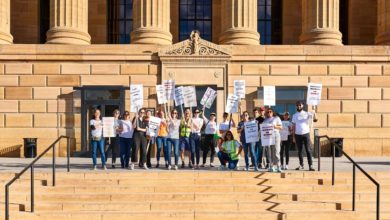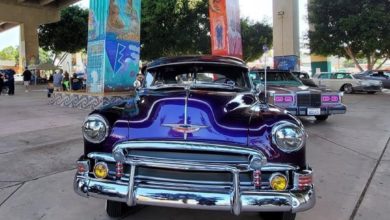For the first time in the United States, the works of contemporary artists from Palestine have been brought together in a museum-quality exhibition. “Made in Palestine,” which opened at the Bridge Gallery in New York City on March 14, brings together the work of more than 20 artists. It is a momentous and historic act against the attempts by the U.S. and Israeli governments to shroud the culture and arts of Palestine.
“Made in Palestine” was three years in the making. Events to raise money for the exhibition and all the associated expenses took place around the country. The exhibition first opened in Houston in 2003, and since has traveled to San Francisco and Vermont.
 “A Time to Cast Stones,” by Rajie Cook. |
The organizations Al-Jisser and Al-Awda Palestine Right of Return Coalition were instrumental in supporting the exhibition in New York.
The inception of the exhibit can be traced back to director James Harithas’ deepening desire to organize a collection of Palestinian artists in an exhibition at the Station Museum in Houston, Texas. At around the same time, artist and art historian Samia Halaby had recently completed a book entitled “Liberation Art of Palestine.”
The arts and culture of Palestine suffered greatly amid the horrific repression Israel carried out against Palestine—the destruction of homes, businesses and agriculture; the forced exile of the Arab community; torture and deaths of Palestinians.
After the Six-Day War in 1967 and the first Intifada, Palestinian artists began forming art organizations and creating art centers in Gaza, Jerusalem, Ramallah and Beirut against Israeli persecution. The Israeli government suppressed any act promoting Palestinian identity. They began closing galleries and destroyed art studios. Paintings were either confiscated or burned. Even the use of the colors of the Palestinian flag was banned.
Many artists faced either jail or beatings if they continued to create their artwork. In 1982, the Museum of Solidarity with Palestine was bombed, destroying all of its contents.
“Art was crushed less than other things, but they did not want art to go out because the pictures of art bear witness to people and their culture and their history,” Halaby told Socialism and Liberation.
Since 1999, Halaby has compiled an archive of the work of contemporary Palestinian artists who continued to work under the worst oppression. Other artists began working after restrictions were somewhat reduced in later years. As a consequence of this research, Harithas sought out Halaby’s assistance.
Palestinian art stands by itself
A key political point of the exhibit was that the Palestinian art would stand by itself—not as part of a “balanced” view of the Israel-Palestine conflict or as part of the general art of the region.
As a consequence of the Israeli government’s campaign to erase Palestinian art and culture, Houston’s Station Museum was initially unaware of Palestinian artists and their capacity to express their own struggle in the visual arts.
This was an important factor in organizing and fundraising efforts for the New York showing. “The United Nations has had exhibitions on Palestinian art, but they were curated by UN curators. … They exhibited nothing that represented us as a community, as a whole,” said Palestinian activist Rama Kased.
After researching Halaby’s archives, and particularly after traveling to Palestine, the museum curators were eager and committed to supporting the exhibition.
Reactions to occupation
“Made in Palestine” was finally formed based on the work of 23 artists. Twelve of them currently live in the West Bank and Gaza; four live in nearby border areas of Lebanon, Syria and Jordan; the remaining seven live in the United States. Most of the artists have experienced the subjection of the Israeli occupation. The impact is quite notably seen in all the works in display.
In “Blinded History,” artist Rana Bishara silk-screened chocolate onto 55 panes of glass. On the medium, she depicts scenes of devastation and oppressions beginning in 1948 with the creation of the Israeli state through the Intifada of 2003. The glass is hung from the ceiling and placed in a maze-like composition creating a sense of optical disorientation. The chocolate is used to recollect the bloodshed. The transparency of the images emphasizes both the clarity of these injustices and yet also the role the media has played in obscuring these accounts with the diluteness of the images.
The photographs of Rula Halawani and Noel Jabbour expose the visual landscape of Israeli occupation. Halawani concentrates on illustrating in a more up-close manner the scenes within Gaza and the West Bank. She also gives a face to the families of the region. Halawani, who teaches in Jerusalem, is one of the few Palestinians allowed to cross the checkpoints into the West Bank to photograph the devastated areas, which are patrolled by tanks. Jabbour focuses on shooting portraits of families whose sons are fighters in the resistance forces.
Zuhdi Al Adawi and Muhammad Rakouie were themselves part of the resistance and were imprisoned. Inside prison, the artists were subjected to unspeakable torture. Any self-expression through drawing or writing was explicitly banned. Al Adawi and Rakouie smuggled in crayons and created the social-realism style works on pillowcases in their cell.
Vera Tamari’s “Tale of a Tree” work represents the devastation of olive trees as a result of the apartheid-like walls that the Israeli government is building to encircle and repress the Palestinian territories.
Tyseer Barakat burned images within a map drawer that he had found discarded. The drawer had held maps of Palestinian neighborhoods.
Despite the constant violent persecution and degrading oppression of the Israeli occupation of the Palestinian nation, the art pervades the gallery, forcing you to freeze and contemplate. It radiates the constant struggles of the people. It forces one to feel how real the Intifada was and continues to be, to sense the great tragedy and the heroic struggles of the Palestinian people.
“Made in Palestine” is an important contribution toward breaking down the racist stereotypes against the Palestinian people. “It contradicts the media image that they have been dispersed of who Palestinians are,” Halaby noted.
“They want to present us not only as terrorists but also as a poor and malnourished people, the kind of people who would not be able to create the kind of holy art of the bourgeoisie.”
The exhibit stands as a powerful counterpoint to that lie.
Articles may be reprinted with credit to Socialism and Liberation magazine.






